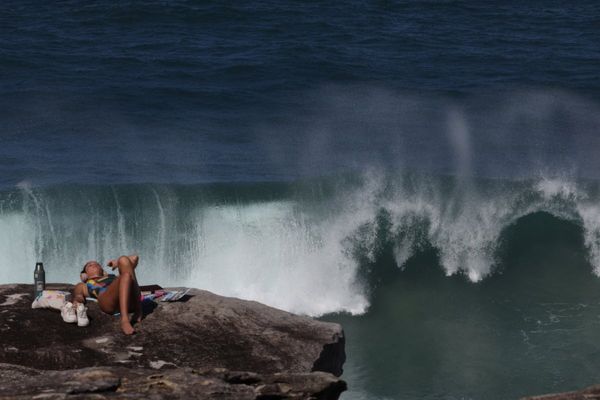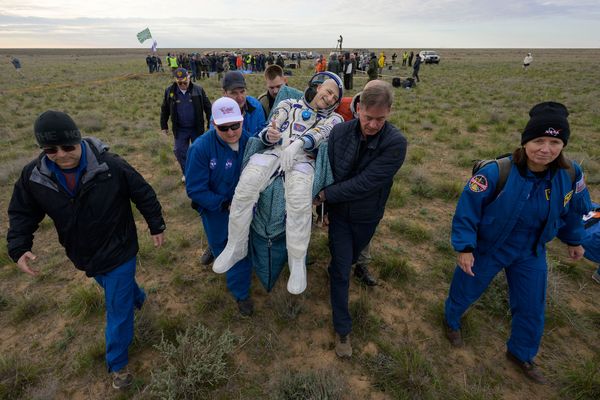
With each one attaining some increase in production value and aesthetic, the release of video edits of lengthy Saquon Barkley touchdown runs have become something of events unto themselves. Versions with and without broadcasters are cut and edited. End zone angles. Sideline angles. Clips of Barkley himself meeting with the photographers and videographers who have become a part of this romp into history.
But no matter how hard we look at the most famous clip of his season—a breathtaking, snow-scattered run in the divisional round of the playoffs that helped heave the Philadelphia Eagles past the unkillable Los Angeles Rams—it’s impossible to spot Greg Delimitros, Craig Blake, Peter Gould, Nick Still or Edward Miller. Nor are their names mentioned in concert with the moment, given how aggressively they eschew the attention. This is, of course, like airing a movie without rolling the credits and acknowledging the editors, set designers and stunt actors.
Delimitros, the Eagles’ vice president of equipment operations, told me in a recent interview that, “It’s all the player. We’re happy the player makes the plays,” though current and former Eagles light up when the equipment staff is brought up. Delimitros has been known to next-day ship emergency cleats to players who were training independently in their backyards and noticed a hint of discomfort. He has attained a kind of sage-like status in which, players say, he can answer a question about some obscure piece of equipment simply by reading the body language of someone walking into the equipment space.
There are moments when new equipment is placed in a locker the week before a game, which should be taken as a strong suggestion on behalf of the equipment staff based on their exhaustive research of the elements and field conditions, which begin days and sometimes weeks before kickoff.
“Playing in the Northeast, with the cold, the frozen ground, they just do a great job preparing us with the equipment, with the benches on the sideline, the heating equipment, everything at practice,” All-Pro Eagles linebacker Zack Baun said. “Shout out to them.”
Baun followed by saying: “I’m glad you [asked] about that.”
Perhaps that’s because, while every NFL equipment staff is important, Philadelphia’s has been looked at with a new perspective on the heels of Super Bowl LIX. Twice this year, once in the season opener against the Green Bay Packers on a first-time football field in Brazil and again against the Rams in a slushy, sleety downpour in the playoffs, the games necessitated one of many critical calls that come from the equipment office. Chief among them when it comes to Barkley’s 78-yard touchdown run was the switch from molded cleats to seven-stud cleats, which give players increased traction. Had the Eagles lost a narrow game to the Packers in Brazil, it may have prevented their ability to rest starters at the end of the season. Had Barkley not been able to accelerate properly on the 78-yard breakaway run, we may be talking about the Rams preparing to face the Kansas City Chiefs in the Super Bowl.
More than 7,000 pounds of equipment is shipped from the Eagles’ home base to Lincoln Financial Field every game day. While cleat inserts represent a small portion of that, the decision to wear the correct ones can carve out the difference between an iconic touchdown run and a sub-zero belly flop.
“If you don’t have the right cleats, you’re screwed, you’re screwed,” says Vinny Curry, a 10-year NFL veteran and former Eagle now working in the media at PHLY. Curry would know—he played in another one of Delimitros’s masterpieces: a 2013 Eagles game against the Detroit Lions in which Lincoln Financial Field was piledrived with eight inches of cotton-white snow that made even viewing the game on television an impossibility. “But Greg, Greg’s gonna make sure.”
Delimitros remembers making the recommendation for seven-stud cleats before the Lions game as well, though it took some players, such as star running back LeSean McCoy, some time to break away from the molded cleats that made him feel more comfortable. Some players dislike the feel of seven-stud cleats and require some convincing. McCoy ran 29 times for 217 yards and two touchdowns in the game, a 34–20 win between two teams that entered the day 7–5. The win propelled the Eagles to an NFC East title.
Delimitros credits buy-in from position coaches, who relay the importance of equipment suggestions. Against the Rams, he says, this was especially critical because the weather wasn’t severe before kickoff, which could have led players to believe that they could survive sticking with their original footwear. While his staff performs a NASCAR pit crew-style cleat cleaning during television timeouts in an effort to remove the lodging of snow in the webbing of the spikes—another hidden, thankless task—there is still the matter of making a case. Gould, Delimitros says, often takes the lead on shoe outfitting for the week and has more than 50 pairs prepped before the game.
Of course, Delimitros could be selling his persuasive powers short. For more than two decades, he’s constantly obsessed over evolving equipment technology, customizing gear to the unique specifications of every player, researching products that could reduce lower-body injuries or force impact on muscles and joints, and tweaking models of shoulder pads and helmets to specify a desired movement. The belief becomes: Cross him at your own risk.
“When someone doesn’t listen? Ooooooooooooooooooooohhh,” Curry says, laughing. “You didn’t listen AND you messed up?”
While the stakes of a game on turf at the Superdome in New Orleans are much lower, and while Delimitros may not have to reach into his equipment haul for adjusted spikes on Super Bowl Sunday, there is a certainty that he and his staff have already identified other potential threats. And somewhere, within that 7,000-pound bag of equipment, is another essential part of a critical play he won’t take credit for.
This article was originally published on www.si.com as Eagles’ Equipment Staff Has Been Unsung Hero of Super Bowl Run.







